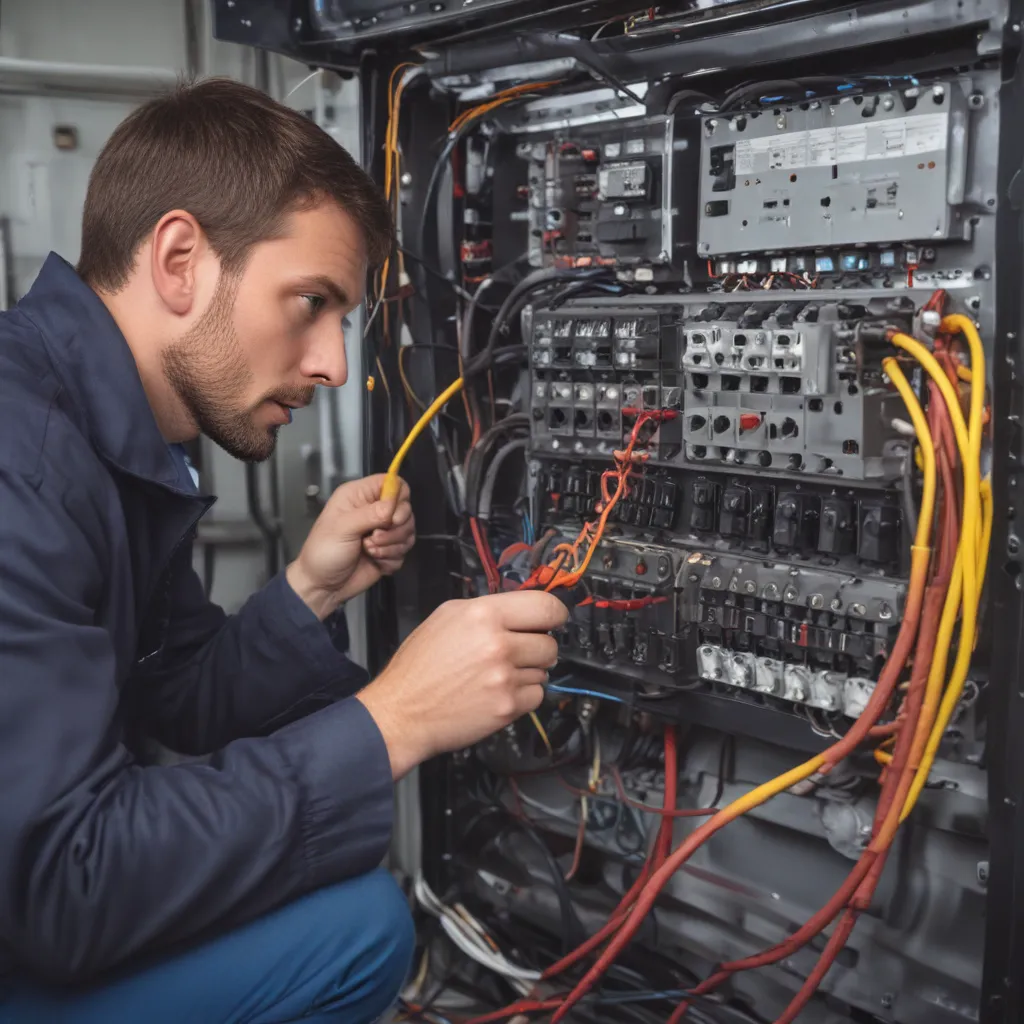
Understanding the Complexity of Fleet Vehicle Electrical Systems
Ah, the joys of working on fleet vehicles! It’s a world of bewildering wires, baffling blinky lights, and gremlins that seem to defy all logic. As the resident electrical guru at Orange County RV Repair, I’ve seen it all – from the perplexing “my-turn-signal-only-works-when-the-moon-is-full” conundrum to the mind-bending “my-entire-dashboard-is-disco-dancing” dilemma.
But fear not, my fellow mechanics and vehicle enthusiasts! In this comprehensive guide, I’ll take you on a journey through the complex realm of fleet vehicle electrical systems, armed with the knowledge and tools to conquer even the most vexing electrical faults.
Mastering the Fundamentals: Fleet Vehicle Electrical Systems Explained
Let’s start with the basics, shall we? Fleet vehicles – whether they’re hulking work trucks, zippy delivery vans, or stately RVs – are a veritable smorgasbord of electrical components, all working in tandem to keep these behemoths running smoothly. From the battery that kickstarts the whole shebang to the intricate network of sensors, controllers, and wiring, these systems are the lifeblood of any fleet vehicle.
But here’s the kicker: each make and model has its own unique electrical architecture, like a fingerprint or a secret handshake. That means a problem that may be a piece of cake to fix in one vehicle could be an absolute headache in another. It’s like trying to solve a Rubik’s Cube while blindfolded and wearing oven mitts – not for the faint of heart!
Tackling the Tricky Stuff: Diagnosing Electrical Faults
Now, let’s dive into the nitty-gritty of diagnosing those pesky electrical faults. As an experienced fleet vehicle repair technician, I can tell you that this is where the real fun (and frustration) begins. Picture this: you’ve got a van that won’t start, a truck with flickering lights, and an RV where the air conditioning seems to have a mind of its own. Where do you even begin?
The key, my friends, is to approach it with a methodical, step-by-step process. First, we’ll need to break out the trusty multimeter and start tracing the circuits, hunting for those elusive open or short circuits. Then, we’ll delve into the vehicle’s computer system, using specialized diagnostic tools to interrogate the various modules and sensors, coaxing them to reveal their secrets.
Real-World Examples: Solving Challenging Electrical Issues
Let me share a few real-world examples of the electrical challenges we’ve faced at Orange County RV Repair. Take, for instance, the case of the delivery van with a mysterious battery drain. The customer complained that the vehicle would lose its charge overnight, leaving them stranded in the morning. We put on our Sherlock Holmes hats and meticulously checked every circuit, only to discover that a faulty alternator was the culprit – it was overcharging the battery, causing it to discharge prematurely.
Or how about the time we tackled the conundrum of the RV with the intermittent lighting issue? The owner had tried everything, from replacing bulbs to rewiring the entire system, but the problem persisted. After a deep dive into the vehicle’s electrical schematics and a bit of lateral thinking, we traced the issue back to a corroded ground connection – a simple fix that had eluded the previous mechanics.
The Power of Perseverance: Overcoming Electrical Challenges
I’ll admit, sometimes the electrical gremlins can be downright diabolical, cackling and taunting us as we scratch our heads in bewilderment. But that’s where the true mettle of a skilled fleet vehicle repair technician shines through. We don’t give up easily – we’re like electrical Sherlock Holmes, doggedly pursuing the trail of clues until we uncover the root cause.
Take, for example, the case of the work truck that refused to start. The customer had taken it to several mechanics, all of whom had thrown up their hands in defeat. But not us – we rolled up our sleeves, fired up the diagnostic tools, and methodically checked every component, from the battery to the starter solenoid. And you know what we found? A faulty wiring harness, hidden deep within the engine bay, that was causing an intermittent connection. A little rewiring and voila – the beast roared back to life, much to the customer’s delight (and our own).
The Future of Fleet Vehicle Electrical Diagnostics
As technology continues to advance, the world of fleet vehicle electrical systems is only going to become more complex. We’re talking about integrated systems, advanced sensors, and sophisticated computer networks that would make a NASA engineer blush. But fear not, my fellow repair technicians – we’re right there with you, embracing the challenge and staying ahead of the curve.
At Orange County RV Repair, we’re constantly investing in the latest diagnostic equipment, training our team to be masters of the electrical arts, and staying up-to-date on the latest industry developments. After all, in this fast-paced world of fleet vehicles, the electrical gremlins never rest – they’re always lurking, waiting to pounce on the unsuspecting mechanic. But with the right knowledge, the right tools, and the right team, we can conquer even the most daunting electrical faults.
So, the next time you’re faced with a fleet vehicle electrical challenge that has you scratching your head and muttering under your breath, remember: you’re not alone. The wizards of Orange County RV Repair are always here, ready to lend a helping hand and share our hard-won expertise. Together, we’ll solve those baffling electrical mysteries, one circuit at a time.
Visit Orange County RV Repair to learn more about our fleet vehicle electrical repair services.
